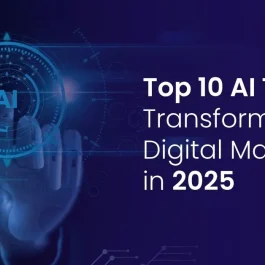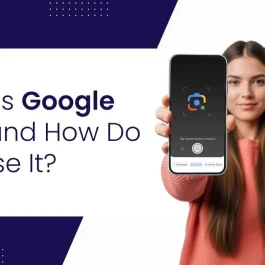6 min read

Generative AI isn’t just another tech trend — it’s transforming how search engines, content creators, and marketers approach visibility and relevance.
In just a few years, it has evolved from a simple writing aid into the backbone of modern SEO and content strategy. Today, it helps brands boost rankings, drive organic traffic, and scale content without losing creativity.
According to Semrush, over 57% of SEO professionals now use AI tools for optimization, and Gartner predicts that by 2026, nearly 30% of all web content will be AI-generated — with humans ensuring quality and trust.
Generative AI is reshaping everything from keyword research to Google’s Search Generative Experience (SGE). Let’s explore how it’s redefining SEO and content strategy in 2025 and beyond.
Table of Contents
1. AI-Generated and Human-Refined Content
Generative AI has moved beyond writing—it’s now a true partner in content creation. With AI tools like ChatGPT and Jasper, marketing teams can quickly create blogs, emails, and product pages that follow SEO best practices and stay true to their brand voice — all at scale.
But quality still requires human creativity. AI handles structure and optimization, while humans refine tone, storytelling, and relevant keywords.
Stat: Teams using AI for content generation produce 1.9× more high-quality content monthly while maintaining consistent search engine rankings (Semrush).
Example: A SaaS company used AI technology to draft blogs about “cloud VoIP benefits.” After human editing and SEO optimization, they saw a 22% boost in search traffic within four weeks.
Action: Build an AI-first workflow — draft with generative AI, refine with human editors, then optimize for search engines and publish.
2. Intent-First Content Creation Using AI Insights
Traditional SEO practices start with keyword research, but today’s AI algorithms focus on user intent. Generative AI studies search queries, trends, and user behavior to predict what people want next. This helps brands create relevant content that matches real-time interests.
Stat: Content aligned with user intent is 45% more likely to appear on the first search engine results page (SERP) (RankRanger).
Example: A SaaS brand analyzed search trends using predictive analytics and AI tools. They discovered new long-tail queries around “remote communication tools” and optimized blogs accordingly, gaining 33% more organic traffic in just 12 weeks.
Action: Use generative AI tools to identify targeted keywords and align them with searcher intent—not just search volume. This ensures your SEO strategy connects with real users and search engines alike.
3. Content Structure for AI and Search Engines
Modern search engine algorithms and AI platforms rely heavily on structured data and schema markup. Optimizing for search results means creating content that’s easy for search engines to read and people to enjoy.
Stat: Websites that use FAQ schema, How-To schema, and clear headings are twice as likely to appear in Google’s Search Generative Experience (SGE).
Example: A B2B agency restructured its blog with schema markup and meta tags. Within six weeks, its search engine visibility increased by 17%.
Action: Format your content so it’s easy for machines to read and for people to scan. Use tables, lists, and structured data to make your site more visible in both traditional and AI-powered search engines.
4. Automated Topic and Keyword Discovery
Keyword research no longer requires endless spreadsheets. AI now helps marketers find emerging search trends and targeted keywords that humans might miss.
AI algorithms study data from search results, forums, and social media to find new opportunities that others might miss.
Stat: Over 54% of SEO professionals say AI helps them find new search queries they wouldn’t have discovered otherwise (HubSpot).
Example: A marketing team used AI to analyze search patterns from Quora and Reddit. They found 50 new topics around “UCaaS security” and saw a 40% jump in organic traffic after publishing well-optimized blogs.
Action: Leverage AI-powered keyword research tools to stay ahead of search trends and maintain a competitive edge.
5. Multilingual and Localized Content at Scale
AI models make content optimization and localization effortless. With AI technology, brands can create natural-sounding translations that keep content quality high and automatically adjust to each culture’s tone.
Stat: Companies that use AI tools for multilingual SEO see 47% more organic traffic in new regions (Common Sense Advisory).
Example: A tech firm repurposed its English blogs into French, Spanish, and Hindi using generative AI. It increased search engine visibility across non-English markets by 38%.
Action: Combine AI-driven translation with human editing for global reach and consistent brand voice.
6. Personalized Content Streams
AI allows brands to deliver relevant content tailored to each visitor’s user intent. By studying user behavior, AI predicts needs and personalizes on-site messaging in real time.
Example: A finance company used AI to show personalized blog titles based on location and industry. Result — 18% higher engagement and 12% more organic traffic.
Stat: McKinsey reports that personalized experiences can increase conversion rates by up to 15%.
Action: Use AI tools to study your own data, tweak your messages in real time, and create experiences that connect right away.
7. Voice and Conversational SEO
Voice search and conversational SEO are redefining how users interact with search engines. Optimizing for voice search means understanding natural language processing (NLP) — the AI technology that helps systems recognize and interpret how people naturally speak.
Example: Instead of targeting “best VoIP software,” a business can focus on conversational queries like “What’s the best VoIP system for remote teams?”
Stat: More than 30% of global searches now come from voice-enabled devices.
Action: Use NLP optimization, conversational keywords, and FAQ sections to boost your visibility in voice results and AI-powered search algorithms.
8. Rapid Content Refresh and Optimization
AI enables brands to keep their existing content fresh and relevant. With real-time insights, it suggests updates to maintain high search engine rankings and SEO performance.
Example: A news site used AI algorithms to refresh outdated articles automatically. It achieved a 22% boost in search rankings and more organic traffic within months.
Stat: Regularly updated blogs perform 67% better in search results than static pages (SEMrush).
Action: Implement automated content optimization to review old posts, improve meta tags, and maintain consistent online visibility.
9. Content Automation and Workflow Integration
AI now supports every stage of the content creation process — from brainstorming to publishing. Integrating AI platforms with CMS and analytics tools ensures faster workflows and data-driven decision-making.
Example: A digital agency automated content marketing workflows with AI, reducing turnaround time by 35%.
Stat: Companies that use AI automation publish content 30% faster and see a boost in SEO performance (MarketingProfs).
Action: Use AI to link your content creation, SEO tracking, and analytics tools — building a smart system that keeps improving with every update.
10. Ethics, Trust, and Authenticity in AI Content
As AI technology evolves, human oversight remains critical. Search engines reward transparency, originality, and trustworthy content.
Stat: According to Forrester, 71% of users prefer brands that clearly disclose AI-generated content.
Example: An eCommerce brand added a small note — “Created with AI assistance” — to its product blogs. This simple change boosted user trust and lowered bounce rates.
Action: Blend automation with human creativity and ethical editing. Staying authentic, compliant, and transparent builds lasting trust with both readers and search engines.
Final Thoughts
Generative AI is redefining SEO and content strategy by combining the power of technology with the art of human creativity. For agencies like Varun Digital, the goal isn’t just to use AI—it’s to use it wisely. The goal is to improve SEO performance and keep content real. It’s about creating experiences that connect deeply with people and work well for search engines.
As the digital world keeps changing, brands that use AI wisely, organize data clearly, and follow honest SEO practices will stand out. They’ll build strong visibility, trust, and steady growth that lasts. They’ll be better prepared to adapt to new search trends and stay relevant as search engine algorithms continue to evolve.
In the end, great content isn’t just about ranking higher. It’s about building trust, connecting with your audience, and growing steadily through the smart use of Generative AI.
Transform Your SEO With AI
Boost rankings, scale content, and match user intent using smarter AI-first strategies that deliver results.
Frequently Asked Questions
Q1. How is generative AI changing SEO?
Generative AI makes SEO smarter by automating content creation, finding better keywords, and optimizing pages for search results with the help of predictive analytics and natural language processing (NLP).
Q2. Does AI content hurt SEO rankings?
Not if it’s done right. Search engines care about quality, relevance, and human oversight — not whether your content was created with AI.
Q3. How can small businesses use AI for SEO?
By utilizing affordable AI tools, brands can identify more effective keywords, create compelling meta tags, and refine content to enhance search visibility and increase organic traffic.
Q4. What is Generative Engine Optimization (GEO)?
It’s the next step in SEO — optimizing content for AI-driven search engines, such as Google’s Search Generative Experience (SGE), which delivers summarized results directly on the page.
Q5. How does AI improve keyword research and analysis?
AI tools study search algorithms, user behavior, and queries to find the right keywords and predict future search trends with greater accuracy.
Published: November 7th, 2025




